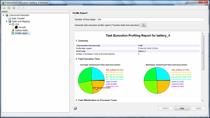Onboard Battery Pack State of Charge Estimation Using a Trained Neural Network
Trevor Jones, Gotion, Inc.
Using battery cell charging data stored in Gotion’s cloud data platform, we train and validate a neural network to estimate pack state of charge (SOC) during vehicle charging with the Deep Learning Toolbox™ and in-house data query API. We create an onboard SOC estimation strategy in Simulink® using the trained neural network. Afterward, we verify the algorithm’s ability to meet functional requirements using Simulink Test™ and deploy it as a “shadow” strategy within an existing AUTOSAR SOC software component. The impact on CPU and memory resources of the microcontroller is evaluated first. Then, we evaluate the neural network-based SOC estimator on test vehicles and find that the results (< 3%) are promising.
Published: 1 Jun 2022




